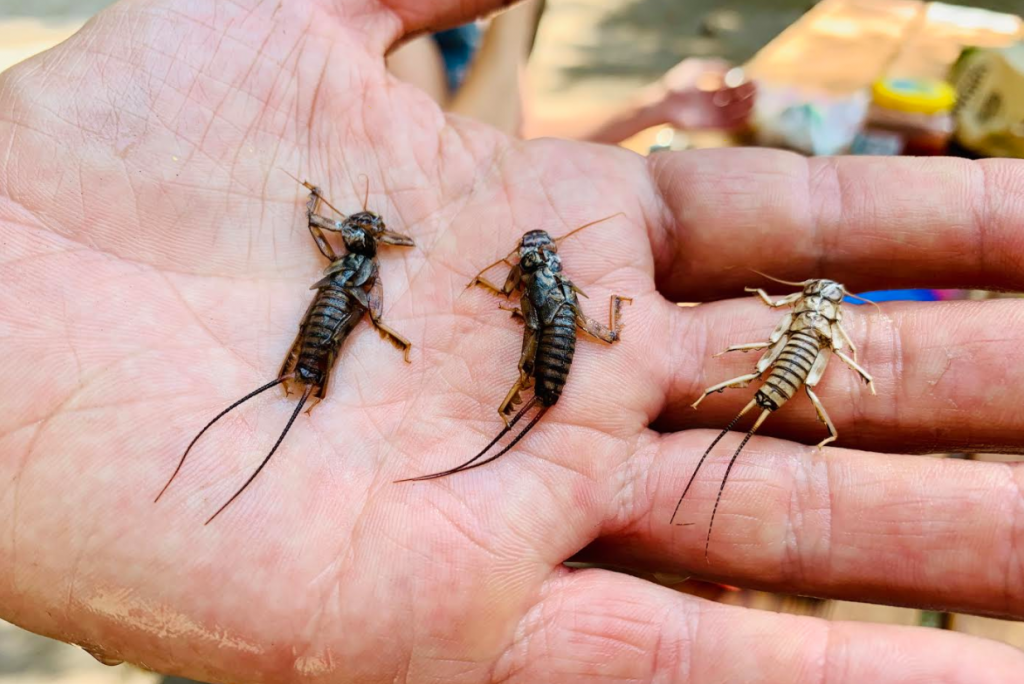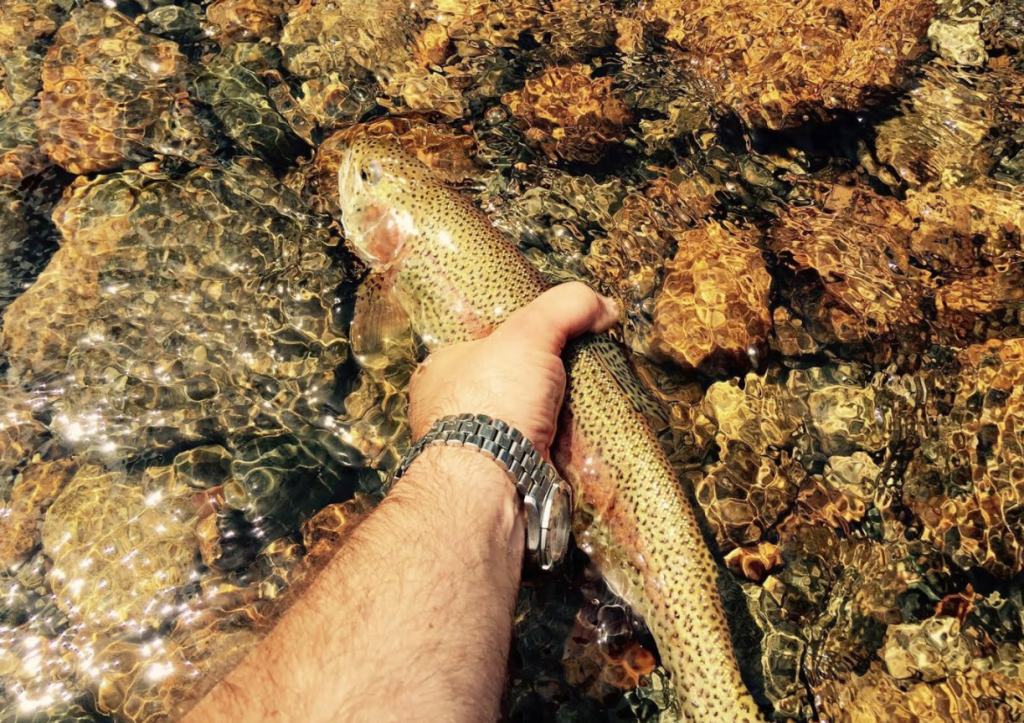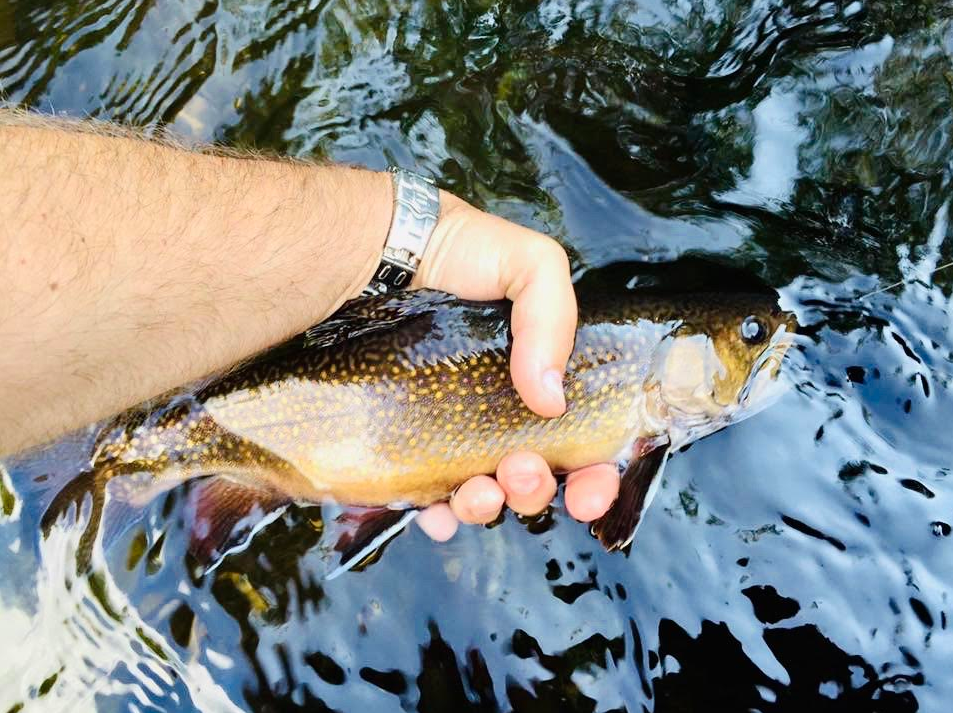The Swift River is located in the heart of the White Mountains National Forest (WMNF) and offers some incredible fly fishing opportunities.
Here Are Links To Information Within This Article:
General Rules | Flies To Use | Where To Fish | Current Flows
About The Swift river
Type: Freestone
Size: Medium
Location: Northeastern NH
Length: 25.6 miles
Nearest Towns: Livermoore, Waterville Valley, Albany, and Conway
Season: January 1st through October 15th (best time to fish late spring, summer, and fall)
Regulations & Permitting: WMNF parking pass required in most areas, NHF&G fishing license required
General Fishing Rules for Rivers & Streams: 5 fish or 5 lbs. daily limit, whichever is reached first; no length limit (Refer to NH&G Freshwater Digest for further details)
Flows: uncontrolled, seasonally dependent on snow pack and precipitation
Access: Ample throughout
Species: Brook Trout: (NH’s state fish) (native, wild, stocked, with holdover potential) Rainbow Trout: (wild, stocked, with holdover potential) Brown Trout: (wild, stocked with holdover potential)
The Swift River is a classic northern New England freestone fishery. It originates on Mt. Kancamagus, near the unincorporated town of Livermore, NH. The Swift River flows easterly through the towns of Waterville Valley, Albany, and Conway along NH Rte. 112, the Kancamagus Highway, before it’s confluence with the Saco River in the town of Conway. The Swift River is a 25.6 mile gem that is undammed and free flowing throughout its entire course descending over 2,400 turbulent feet in elevation before emptying into the Saco River. The bulk of the Swift River is located within the White Mountain National Forest, meaning the watershed is predominantly located on federally protected forestlands providing for exceptional water quality and excellent accessibility. The Swift River watershed is part of the greater upper Saco River Basin. The Swift River was designated into the NH Rivers Management and Protection Program in June of 1990.
General Rules And Regulations
The Swift River is open from January 1st to October 15th per calendar year; it is normally inaccessible in its upper most stretches until mid-April into early May due to heavy snow pack and river ice found along its course, try and stick to the lower sections if possible when getting out early in the season. By mid to late May most access points are free and clear under normal circumstances. Under general law the Swift River has a 5 fish or 5 pounds daily limit, whichever is reached first; no length limit, and is open to all anglers. It is predominantly recreated by fly anglers.
Fly Fishing Only Section:
The Swift River does not have any fly fishing only sections. If you go into the NH state special regulations, you will find that the “Swift River” does have a FFO section, but this is referring to a different swift river located between Sandwich and Tamworth. “The swift has a fly fishing only section from Rte. 113A Bridge downstream to Rte. 113 Bridge. ”
This can of course be confusing, so we wanted to point this out.
You can read about the NH rules and regulations for the Swift here: https://www.wildlife.state.nh.us/fishing/seasons.html
Where To Fish The Swift
Upper Swift River Angling Opportunities:
The Swift River supports abundant native brook trout populations in the upper main stem and tributaries. It is a walk to/hike to wade-able fishery. Plan on using your WMNF parking pass to park at trailheads and access off road parking where available. With a little research, preparation, and common sense you can get off the grid to locate fish in less pressured areas fairly easily. If you happen to be a novice or are new to the area, play it safe and hire a licensed NH Guide with WMNF outfitter/guide permitting your first few times out.
Concentrate your fishing efforts to deep plunge pools, the confluences with feeder tributaries, in/around structure (rocks, woody debris, undercut banks etc.). In the warmer months always remember to try the oxygenated riffle sections too. Late summer anglers should remember to monitor their water temperatures as they tend to become elevated when water levels drop during this time of year. A good rule of thumb is to forgo angling activities when water temps hit 70 degrees and above. This is done to help preserve our native brook trout populations as they have low thermal tolerance thresholds.
High Country native brook trout can require a bit of effort; walking/hiking to seek out, stealth in your approach, and patience to entice, but are considered the jewels of the North Country and prized by many. Native brook trout within the headwater portions of the Swift River system can range in size from the young of the year (parr) 2-3” in length up to 10-14” in length in some cases. When actively feeding, native brook trout can have voracious appetites and provide an unmatched experience for those willing to put in the effort.
Lower Swift River Angling Opportunities:
Further down the Swift River towards the towns of Albany and Conway anglers can also find some quality native brook trout. These homegrown fish will be mixed in with New Hampshire Fish & Game stocked brook trout, rainbow trout, and the occasional brown trout that has migrated up from the Saco River. There are several easily accessible fishing areas to choose from including; Rocky Gorge Scenic Area, and the Covered Bridge Campground which features a fishing platform installed by the White Mountains National Forest. A stop at the confluence of the Swift and Saco Rivers in Conway can also produce some very good results.
Lastly, you can also walk the river banks and concentrate your fishing efforts as discussed in the upper sections of the Swift River to avoid the foot traffic. The lower stretches of the river can see high use during the summer months so try and plan your trips accordingly during off hours to maximize your experience. There is also the opportunity to get into some lesser known sections of the lower river with the assistance of a guide. Fish in the lower sections of the Swift River range in size from the young of the year native brook trout (parr) 2-3” in length up to 16-18” stocked brook, rainbow, and brown trout.
Swift River Fishing Map
Best Flies For The Swift River
Nymphs & Soft Hackle Patterns: (sizes 14-22) pheasant tail, gold ribbed hares ear, black stones, wd-40, frenchies, prince nymph, copper john, brassie, green caddis, Ellis Hatch’s hatching pupa, rainbow warrior, soft hackle spiders, soft hackle pheasant tail, soft hackle hares ear, soft hackle green caddis (sizes, colors, bead head and weighted as conditions dictate)
Streamer Patterns: (sizes 6-12) wooly bugger, muddler minnow, egg sucking leech, black ghost, little brook trout, little rainbow trout, little brown trout, hornberg (sizes, colors, bead head and weighted as conditions dictate)
Dry Fly Patterns: (sizes 12-22) adams, bwo, royal coachman, stimulator, elk hair caddis, white wulff, royal wulff, hornberg, griffth’s gnat, hendrickson, red quill, grasshoppers, chernobyl ants, beetles (sizes, and colors as conditions dictate)
Misc. Patterns: (sizes 10-14) mop flies, squirmy worm, san juan worm (sizes, colors, bead head and weighted as conditions dictate)
Current Swift River Waterflow
Here are the current waterflows for the Swift River:
https://waterdata.usgs.gov/nwis/uv/?site_no=01064485
Additional Pictures

Stoneflies From The Swift River

Rainbow From The Swift River

Brook Trout From The Swift River
Randy Ouellette is a fully insured and licensed NH Fishing Guide holding a White Mountains National Forest outfitter/guiding permit residing in Conway NH. Randy is the President of Saco Valley Trout Unlimited, the Vice President of NH Trout Unlimited, and a member of the Saco-Swift River Local Advisory Committee and is committed to the restoration, preservation, and protection of our local cold water fisheries. You can find his site here: https://theswiftriverghillie.com/
